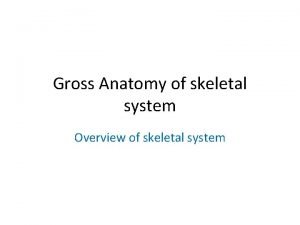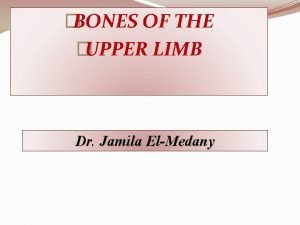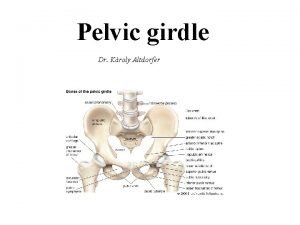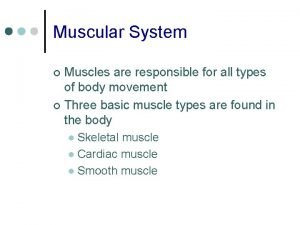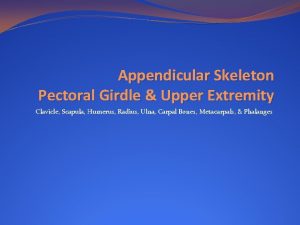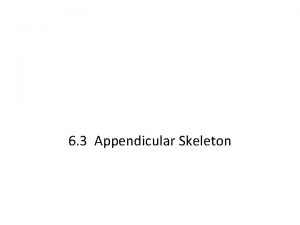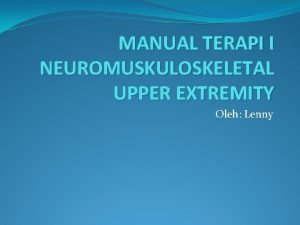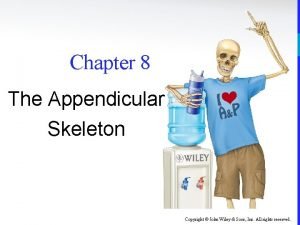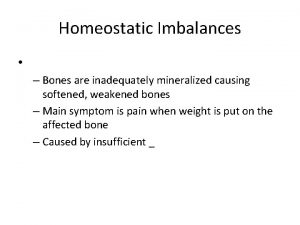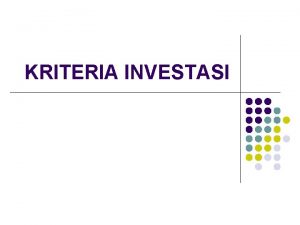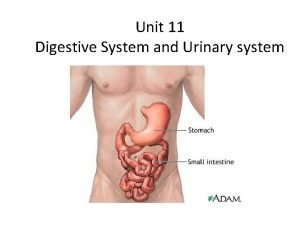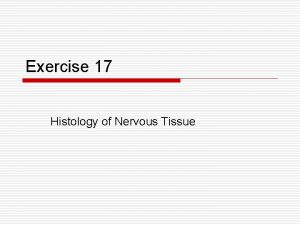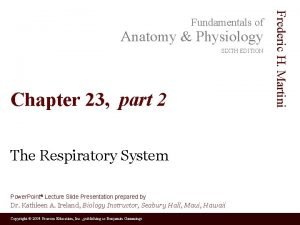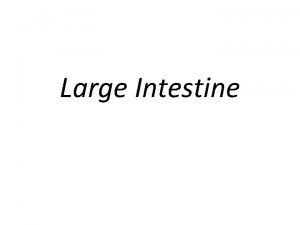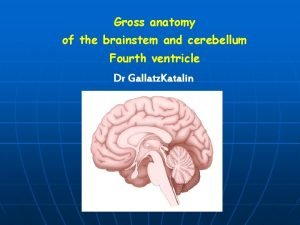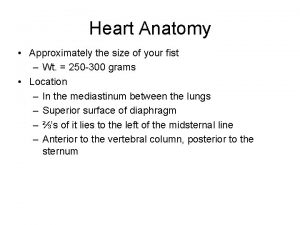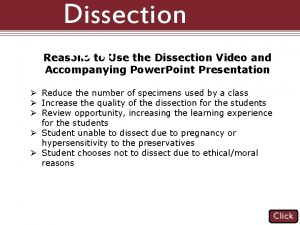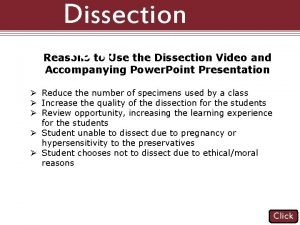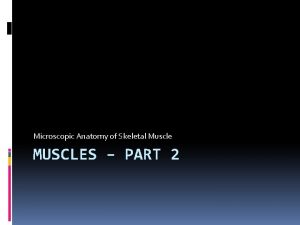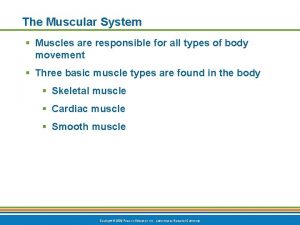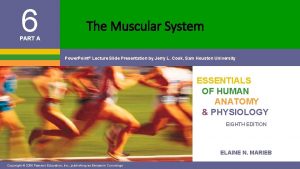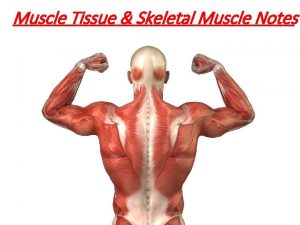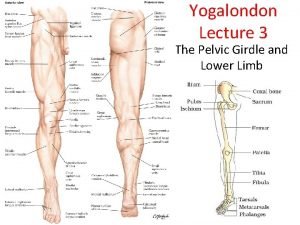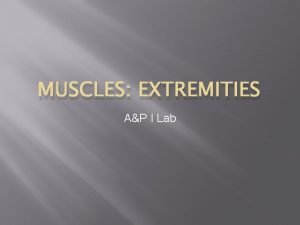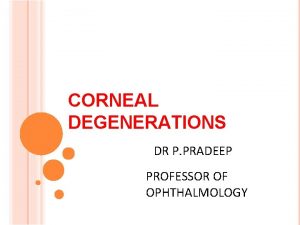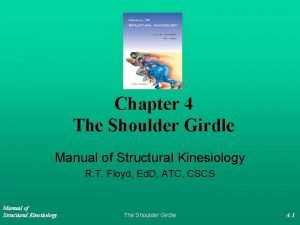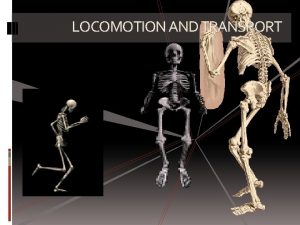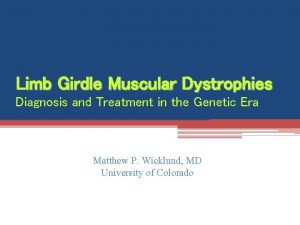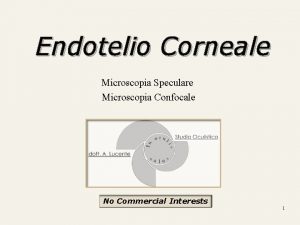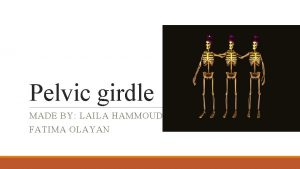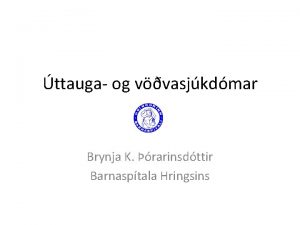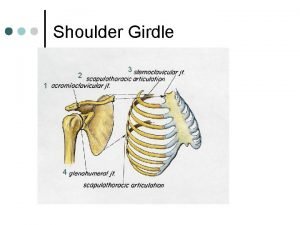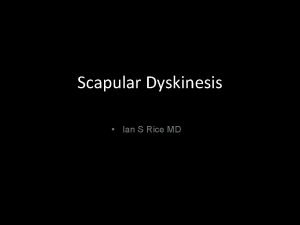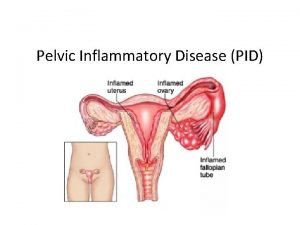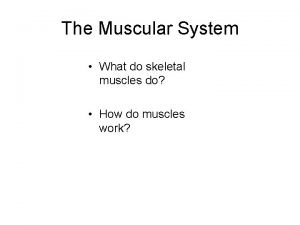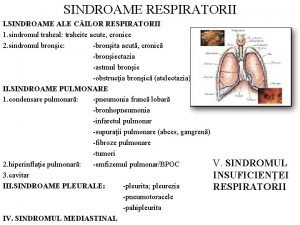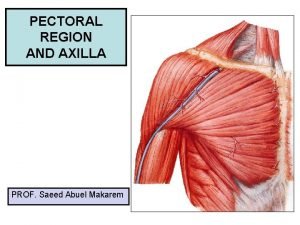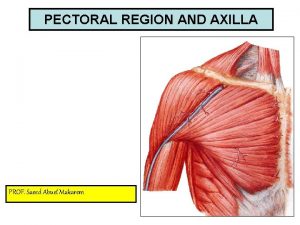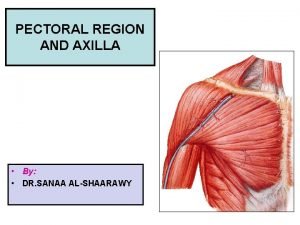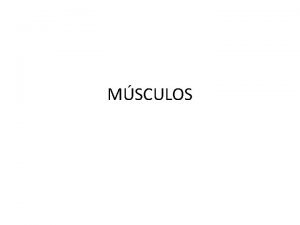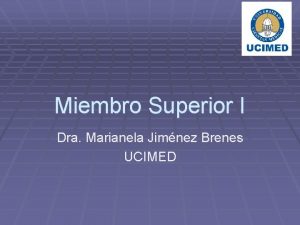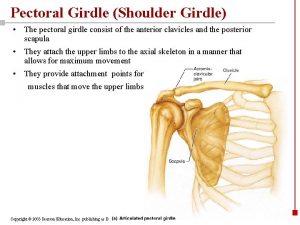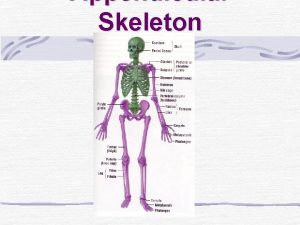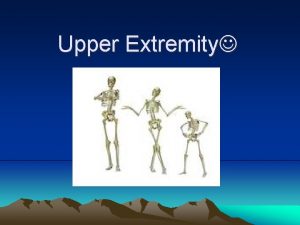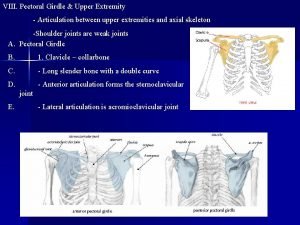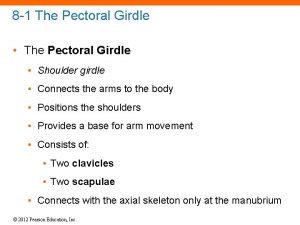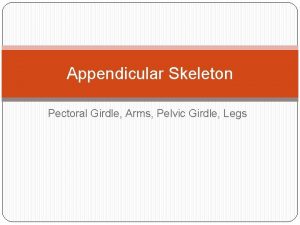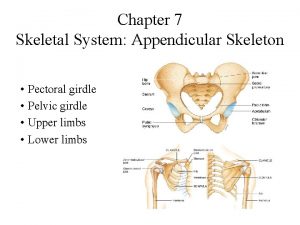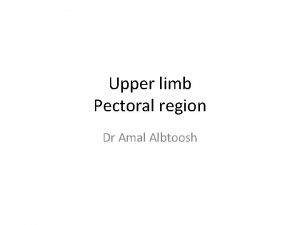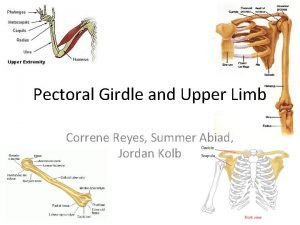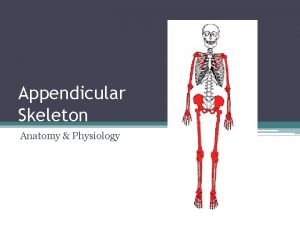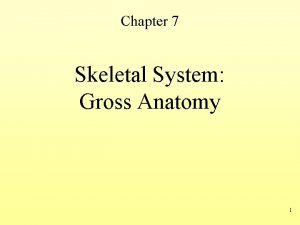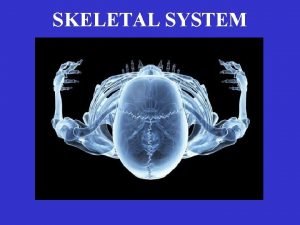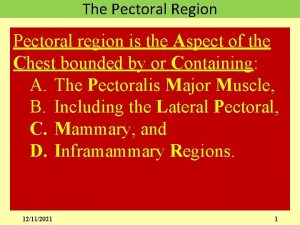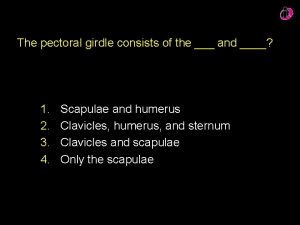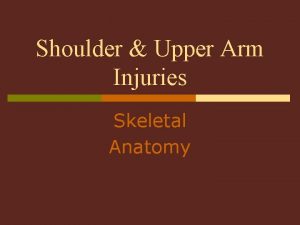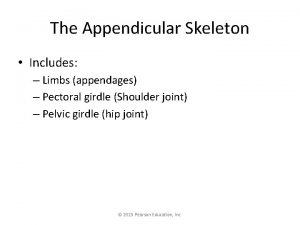Skeletal System Gross Anatomy Pectoral Girdle and Upper





















































- Slides: 53

Skeletal System- Gross Anatomy Pectoral Girdle and Upper Limb Pelvic Girdle and Lower Limb Introduction Skull Spine and Rib Cage $100 $100 $200 $200 $300 $300 $400 $400 $500 $500 FINAL ROUND

Introduction: $100 Question This is not part of the appendicular skeleton: a. pectoral girdle b. pelvic girdle c. lower limb d. coccyx e. All of these are part of the appendicular skeleton ANSWER BACK TO GAME

Introduction: $100 Answer This is not part of the appendicular skeleton: a. pectoral girdle b. pelvic girdle c. lower limb d. coccyx e. All of these are part of the appendicular skeleton BACK TO GAME

Introduction: $200 Question The axial skeleton protects the brain, spinal cord, and vital organs in the thorax. True/False ANSWER BACK TO GAME

Introduction: $200 Answer The axial skeleton protects the brain, spinal cord, and vital organs in the thorax. True/False BACK TO GAME

Introduction: $300 Question The anatomical term for a hole in a bone that was once occupied by a nerve or blood vessel is known as this: a. foramen b. meatus c. fossa d. sulcus ANSWER BACK TO GAME

Introduction: $300 Answer The anatomical term for a hole in a bone that was once occupied by a nerve or blood vessel is known as this: a. foramen b. meatus c. fossa d. sulcus BACK TO GAME

Introduction: $400 Question This bone marking refers to a smooth, rounded articular surface: a. tubercle b. facet c. condyle d. tuberosity d. trochanter ANSWER BACK TO GAME

Introduction: $400 Answer This bone marking refers to a smooth, rounded articular surface: a. tubercle b. facet c. condyle d. tuberosity d. trochanter BACK TO GAME

Introduction: $500 Question This best describes the primary function of a process or tubercle: a. connects one bone to another b. attachment for ligaments and tendons c. creates a stress point on a bone d. found at joints ANSWER BACK TO GAME

Introduction: $500 Answer This best describes the primary function of a process or tubercle: a. connects one bone to another b. attachment for ligaments and tendons c. creates a stress point on a bone d. found at joints BACK TO GAME

Skull: $100 Question The parietal and frontal bones are joined together by this suture: a. squamous b. coronal c. sagittal d. lambdoid ANSWER BACK TO GAME

Skull: $100 Answer The parietal and frontal bones are joined together by this suture: a. squamous b. coronal c. sagittal d. lambdoid BACK TO GAME

Skull: $200 Question The brain and spinal cord are connected through this opening in the skull: a. foramen rotundum b. foramen ovale c. foramen magnum d. mental foramen ANSWER BACK TO GAME

Skull: $200 Answer The brain and spinal cord are connected through this opening in the skull: a. foramen rotundum b. foramen ovale c. foramen magnum d. mental foramen BACK TO GAME

Skull: $300 Question The vomer and this structure together form the nasal septum: a. perpendicular plate of the ethmoid b. lacrimal bone c. palatine process of the maxilla d. nasal bone ANSWER BACK TO GAME

Skull: $300 Answer The vomer and this structure together form the nasal septum: a. perpendicular plate of the ethmoid b. lacrimal bone c. palatine process of the maxilla d. nasal bone BACK TO GAME

Skull: $400 Question The viscerocranium (facial bones) serve as attachment points for the muscles involved in chewing and facial expression as well as protection of the eyes, nose and tongue. True/ False ANSWER BACK TO GAME

Skull: $400 Answer The viscerocranium (facial bones) serve as attachment points for the muscles involved in chewing and facial expression as well as protection of the eyes, nose and tongue. True/ False BACK TO GAME

Skull: $500 Question The mandible articulates with the skull here: a. styloid process b. zygomatic arch c. occipital condyle d. mandibular fossa ANSWER BACK TO GAME

Skull: $500 Answer The mandible articulates with the skull here: a. styloid process b. zygomatic arch c. occipital condyle d. mandibular fossa BACK TO GAME

Spine and Rib Cage: $100 Question There are this many lumbar vertebrae: a. 12 b. 5 c. 7 d. 1 ANSWER BACK TO GAME

Spine and Rib Cage: $100 Answer There are this many lumbar vertebrae: a. 12 b. 5 c. 7 d. 1 BACK TO GAME

Spine and Rib Cage: $200 Question Spinal nerves exit through this opening: a. intervertebral foramen b. vertebral foramen c. transverse foramen d. pedicle ANSWER BACK TO GAME

Spine and Rib Cage: $200 Answer Spinal nerves exit through this opening: a. intervertebral foramen b. vertebral foramen c. transverse foramen d. pedicle BACK TO GAME

Spine and Rib Cage: $300 Question Characteristics of this bone include a small body, bifid spinous process, and transverse foramina: a. thoracic vertebra b. lumbar vertebra c. sacral vertebra d. cervical vertebra ANSWER BACK TO GAME

Spine and Rib Cage: $300 Answer Characteristics of this bone include a small body, bifid spinous process, and transverse foramina: a. thoracic vertebra b. lumbar vertebra c. sacral vertebra d. cervical vertebra BACK TO GAME

Spine and Rib Cage: $400 Question The clavicle and first rib articulate with this specific part of the sternum: a. body b. xiphoid process c. manubrium d. scapula ANSWER BACK TO GAME

Spine and Rib Cage: $400 Answer The clavicle and first rib articulate with this specific part of the sternum: a. body b. xiphoid process c. manubrium d. scapula BACK TO GAME

Spine and Rib Cage: $500 Question This feature of a rib articulates with the transverse process of a vertebra: a. head b. tubercle c. angle d. neck e. body ANSWER BACK TO GAME

Spine and Rib Cage: $500 Answer This feature of a rib articulates with the transverse process of a vertebra: a. head b. tubercle c. angle d. neck e. body BACK TO GAME

Pectoral Girdle and Upper Limb: $100 Question The pectoral (shoulder) girdle is made of this: a. clavicle, scapula and humerus b. sternum, clavicle and scapula c. clavicle, ribs, scapula and sternum d. scapula and clavicle ANSWER BACK TO GAME

Pectoral Girdle and Upper Limb: $100 Answer The pectoral (shoulder) girdle is made of this: a. clavicle, scapula and humerus b. sternum, clavicle and scapula c. clavicle, ribs, scapula and sternum d. scapula and clavicle BACK TO GAME

Pectoral Girdle and Upper Limb: $200 Question These bones form the knuckles of your hand: a. metacarpals b. carpals c. phalanges d. sesamoid ANSWER BACK TO GAME

Pectoral Girdle and Upper Limb: $200 Answer These bones form the knuckles of your hand: a. metacarpals b. carpals c. phalanges d. sesamoid BACK TO GAME

Pectoral Girdle and Upper Limb: $300 Question This part of your ulna is commonly referred to as the elbow: a. ulnar tuberosity b. styloid process c. medial epicondyle d. olecranon process ANSWER BACK TO GAME

Pectoral Girdle and Upper Limb: $300 Answer This part of your ulna is commonly referred to as the elbow: a. ulnar tuberosity b. styloid process c. medial epicondyle d. olecranon process BACK TO GAME

Pectoral Girdle and Upper Limb: $400 Question The biceps brachii muscle attaches to the radius at this point: a. radial tuberosity b. styloid process c. deltoid tuberosity d. head ANSWER BACK TO GAME

Pectoral Girdle and Upper Limb: $400 Answer The biceps brachii muscle attaches to the radius at this point: a. radial tuberosity b. styloid process c. deltoid tuberosity d. head BACK TO GAME

Pectoral Girdle and Upper Limb: $500 Question This best describes the function of the acromion process: a. protects the shoulder joint b. attachment site for clavicle c. attachment point for muscles d. all of these ANSWER BACK TO GAME

Pectoral Girdle and Upper Limb: $500 Answer This best describes the function of the acromion process: a. protects the shoulder joint b. attachment site for clavicle c. attachment point for muscles d. all of these BACK TO GAME

Pelvic Girdle and Lower Limb: $100 Question The ilium, ischium and pubis form this: a. pelvic girdle b. pelvis c. coxal bone (os coxae) d. sacroiliac joint ANSWER BACK TO GAME

Pelvic Girdle and Lower Limb: $100 Answer The ilium, ischium and pubis form this: a. pelvic girdle b. pelvis c. coxal bone (os coxae) d. sacroiliac joint BACK TO GAME

Pelvic Girdle and Lower Limb: $200 Question The female pelvis has a heart-shaped pelvic inlet, ischial spines that are closer together than a male and a subpubic angle that is less than 90 degrees. True/False ANSWER BACK TO GAME

Pelvic Girdle and Lower Limb: $200 Answer The female pelvis has a heart-shaped pelvic inlet, ischial spines that are closer together than a male and a subpubic angle that is less than 90 degrees. True/False BACK TO GAME

Pelvic Girdle and Lower Limb: $300 Question This feature of the femur serves as a muscle attachment site that fastens the hip to the thigh: a. head b. trochanter c. condyle d. epicondyle ANSWER BACK TO GAME

Pelvic Girdle and Lower Limb: $300 Answer This feature of the femur serves as a muscle attachment site that fastens the hip to the thigh: a. head b. trochanter c. condyle d. epicondyle BACK TO GAME

Pelvic Girdle and Lower Limb: $400 Question The process that forms the large bump on the medial side of the ankle is known as the medial _______: a. malleolus b. condyle c. tuberosity d. epicondyle ANSWER BACK TO GAME

Pelvic Girdle and Lower Limb: $400 Answer The process that forms the large bump on the medial side of the ankle is known as the medial _______: a. malleolus b. condyle c. tuberosity d. epicondyle BACK TO GAME

Pelvic Girdle and Lower Limb: $500 Question This arch is formed by the calcaneus, cuboid and two lateral metatarsal: a. medial longitudinal b. lateral longitudinal c. transverse ANSWER BACK TO GAME

Pelvic Girdle and Lower Limb: $500 Answer This arch is formed by the calcaneus, cuboid and two lateral metatarsals: a. medial longitudinal b. lateral longitudinal c. transverse BACK TO GAME

FINAL ROUND Question A paraplegic individual develops pressure sores on the buttocks from sitting in a wheelchair for extended periods. The bony protuberance responsible is this: a. ischial tuberosity b. ischial spine c. pubic tubercle d. anterior superior iliac spine ANSWER BACK TO GAME

FINAL ROUND Answer A paraplegic individual develops pressure sores on the buttocks from sitting in a wheelchair for extended periods. The bony protuberance responsible is this: a. ischial tuberosity b. ischial spine c. pubic tubercle d. anterior superior iliac spine BACK TO GAME
 Gross anatomy of skeletal system
Gross anatomy of skeletal system Biding pektoral girdle and humerus
Biding pektoral girdle and humerus Minor pelvis
Minor pelvis Anterior muscles of the neck
Anterior muscles of the neck The pectoral girdle
The pectoral girdle Pectoral girdle
Pectoral girdle Pectoral girdle
Pectoral girdle Pectoral girdle dibentuk oleh
Pectoral girdle dibentuk oleh Wiley
Wiley Pectoral girdle acetabulum
Pectoral girdle acetabulum Homeostatic imbalances of the skeletal system
Homeostatic imbalances of the skeletal system Rumus gross b/c
Rumus gross b/c Gross anatomy of the gallbladder pancreas and bile passages
Gross anatomy of the gallbladder pancreas and bile passages Exercise 17 gross anatomy of the brain and cranial nerves
Exercise 17 gross anatomy of the brain and cranial nerves Gross anatomy of the lungs
Gross anatomy of the lungs Large intestine
Large intestine Interpeduncular fossa
Interpeduncular fossa Gross anatomy of the heart
Gross anatomy of the heart Gross anatomy of a long bone
Gross anatomy of a long bone Eye dissection
Eye dissection Label gross anatomy of cow eye
Label gross anatomy of cow eye Microscopic anatomy of skeletal muscle
Microscopic anatomy of skeletal muscle Microscopic anatomy of skeletal muscle figure 6-2
Microscopic anatomy of skeletal muscle figure 6-2 Contractile unit of muscle
Contractile unit of muscle Microscopic anatomy of skeletal muscle
Microscopic anatomy of skeletal muscle Anatomy of skeletal muscle
Anatomy of skeletal muscle Inferior ramus of pubis
Inferior ramus of pubis The upper airways
The upper airways Anatomy of the upper respiratory tract
Anatomy of the upper respiratory tract Respiratory zone
Respiratory zone Lymphatics that accompany the cephalic vein drain into the
Lymphatics that accompany the cephalic vein drain into the Linen girdle
Linen girdle Altar vestments and vessels
Altar vestments and vessels Shoulder girdle muscles
Shoulder girdle muscles Vogts white limbal girdle
Vogts white limbal girdle Medial margin
Medial margin Concept map: bones of the pelvic girdle
Concept map: bones of the pelvic girdle Limb girdle weakness
Limb girdle weakness Limbal girdle of vogt
Limbal girdle of vogt Bones of pelvic girdle
Bones of pelvic girdle Limb girdle muscular dystrophy
Limb girdle muscular dystrophy Shoulder girdle landmarks
Shoulder girdle landmarks Medial and lateral scapular winging
Medial and lateral scapular winging Pelvic inflammatory disease
Pelvic inflammatory disease Pelvic girdle pain
Pelvic girdle pain Major skeletal muscles
Major skeletal muscles Skeletal and muscular system
Skeletal and muscular system Pahipleurita rx
Pahipleurita rx Winging of scapula anatomy
Winging of scapula anatomy Boundaries of axilla
Boundaries of axilla Subclavius origin and insertion and action
Subclavius origin and insertion and action Lateral pectoral nerve
Lateral pectoral nerve Tricep braquial funcion
Tricep braquial funcion I.dra
I.dra
